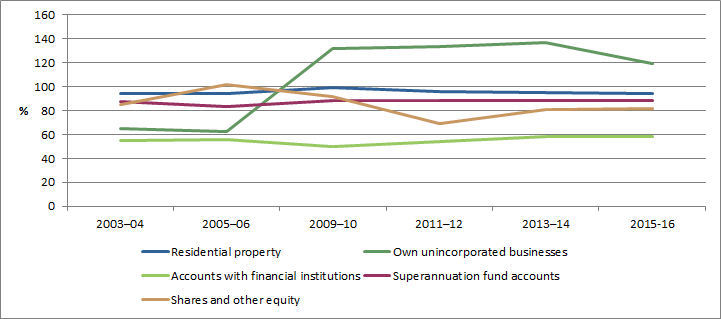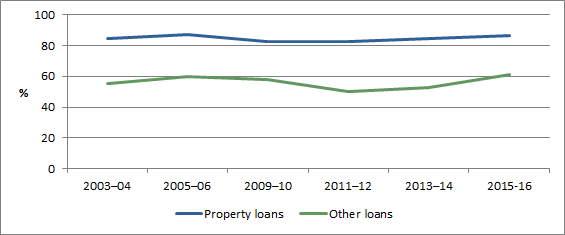WEALTH COMPARISON
The 'SIH-ASNA Wealth comparison' data cube, available in the 'Downloads' tab of this publication, provides the detailed comparison tables between the Survey of Income and Housing (SIH) and Australian System of National Accounts (ASNA) estimates of wealth for the years that SIH wealth data are available. Wealth is only collected for the ‘current’ year in the biennial SIH. It was first collected in SIH 2003–04 and has been collected in all subsequent surveys except SIH 2007–08.
SCOPE AND MEASUREMENT DIFFERENCES
There are a number of scope and measurement differences that can be quantified between the SIH and ASNA household wealth estimates. After adjusting for these differences, the SIH estimate of the value of net worth was 92% ($7,325 billion) of the ASNA estimate ($7,951 billion)
Graph 1 - COMPARISON OF SIH AND ASNA NET WORTH AFTER ADJUSTMENT FOR SCOPE AND MEASUREMENT DIFFERENCES

Source(s): SIH, ASNA
The quantifiable differences, with estimates for 2015–16, are:
- SIH includes the value of household contents and motor vehicles used for private purposes ($846 billion). The most closely related ASNA item is the value of consumer durables ($357 billion) which is not included in the ASNA estimate of net worth in the household sector balance sheet but is included as a memorandum item in the National Balance Sheet (Table 10, cat. no. 5204.0). The valuation methods differ: ASNA estimates actual value, taking into account depreciation; SIH uses insurance value which is normally based on a 'new for old' basis. ASNA consumer durables exclude clothing and household textiles, artworks and antiques that are held as a store of value, and all non-durable household goods;
- ASNA includes other assets not collected in SIH, including unfunded superannuation claims, i.e. the liability of governments to pay superannuation benefits to their employees for which they have not set aside funds ($439 billion); the technical reserves of general and life insurance corporations, i.e. policy holders' net equity in, or claims on, the reserves of general and life insurance corporations which are not relatable to individual households and equate to prepayments of premiums and reserves held to cover outstanding claims ($159 billion), and the capitalised costs of transfers of ownership on real estate transactions, such as stamp duties, legal fees and real estate agents’ commissions ($234 billion); and
- ASNA include the bank deposits of non-profit institutions serving households (NPISHs), such as churches and charities, net of bank borrowings ($20 billion).
WEALTH ITEMS
Graph 2 shows the alignment between the SIH and ASNA for selected wealth data items.
Graph 2 - SIH AS A PERCENTAGE OF ASNA FOR SELECTED ASSETS

Source(s): SIH, ASNA
Residential property assets
Residential property is the largest asset held by the household sector. In 2015–16, the SIH estimate of the value of residential property was 94% ($5,300 billion) of the ASNA estimate ($5,628 billion).
The SIH collects data about the value of dwellings including owner occupied dwellings, second homes (such as holiday homes) and rental investment properties, if not reported as assets of an unincorporated business. Estimates are based on the gross amount respondents would expect to receive if they were to sell their property at the time of interview.
The ASNA uses estimates of the total value of residential dwellings at market value sourced from the quarterly ABS Residential Property Price Indexes: Eight Capital Cities (cat no. 6416.0). The estimates include the total value of residential land plus the dwelling. The value of residential dwellings is based on multiplying the mean price of residential dwellings by the number of dwellings. The calculation is undertaken at the locality level and then aggregated to State and Territory and National level. The mean price of residential dwellings is based on market real estate and Valuers General data. Counts of total dwellings are obtained from the ABS Census of Population and Housing. For intercensal years, dwelling counts are extrapolated forward using dwelling completions, net of demolitions.
Own unincorporated businesses
In the SIH, respondents are asked to provide a net estimate of the value of their own unincorporated businesses (i.e. net of liabilities). Therefore, no information is available about the asset and liability composition of this component. For the purpose of this comparison, the values of non-residential property and private trusts reported in the SIH have been included in the selected assets listed in Table 5. However, any liabilities related to the non-residential property cannot be separately quantified. The increase in the SIH estimate from 2009–10 relates to the separate valuation of private trusts ($183 billion in 2015–16) which have been included in this comparison. Some of this trust income is likely to be reported in other components of the ASNA, including ‘Shares and other equity’.
The ASNA includes information about the individual assets and liabilities by type, and does not identify which assets or liabilities relate to unincorporated business activities and which are used for other purposes. However, some forms of assets and liabilities are most likely to relate to business activities.
In 2015–16, the SIH net value of the selected assets that most closely relate to the operations of unincorporated businesses was $565 billion, while the net value of the selected ASNA assets and liabilities was $475 billion.
Accounts held with financial institutions
The SIH items 'accounts held with financial institutions' and 'offset accounts' are compared to the deposit component (excluding deposits of NPISHs) of the ASNA item 'deposits', and the ASNA item 'loans and placements', that is, deposits with other financial institutions. The SIH items were 58% of the ASNA items in 2015–16 ($524 billion and $904 billion, respectively).
The differences are partly explained by the inclusion of deposits belonging to unincorporated businesses in ASNA items. Deposits of unincorporated businesses are not included in ‘accounts held with financial institutions’ and ‘offset accounts’ in the SIH. These values cannot be separately identified in the SIH, as account balances are reported in net value of these businesses. In 2015-16, one million households were estimated to own an unincorporated business in the SIH. The scope of the SIH also excludes people living in non-private dwellings who may hold accounts with financial institutions.
Superannuation funds
Superannuation is the largest financial asset of households. Respondents are asked to report the total balance in each of their superannuation funds from their last superannuation statement.
The corresponding ASNA item is the pension fund component of insurance technical reserves. The ASNA estimate is derived from information provided to regulatory authorities by the superannuation funds and the ATO for the self-managed funds.
In 2015–16, the value of superannuation assets reported in the SIH was lower than the ASNA estimate ($1,696 billion and $1,921 billion, respectively).
Shares and other equity (including own incorporated business)
The total value of the selected SIH items that relate to shares and own incorporated business equity was $667 billion in 2015–16, compared to the corresponding ASNA estimate of $817 billion.
In the ASNA, the values of listed shares and some unlisted shares are calculated as residuals, that is, the total value of each of these types of shares owned by all sectors is estimated, and the value of shares owned by sectors other than households are subtracted to derive the value of shares owned by the household sector. However these residual items are validated against other economic indicators and information regarding household wealth. The values for other unlisted shares are derived from a range of reported data and other imputed estimates where householders are known to have an ownership interest.
Property loans
In 2015–16, total property loans in the SIH were $1,326 billion compared with $1,534 billion in ASNA.
SIH property loans include the principal outstanding on loans, where the loans have been used both to finance the purchase or construction of, or alteration or addition to, an owner occupied dwelling, or to finance the purchase of other property, as well as loans for non-residential property not treated by respondents as part of the liabilities of their unincorporated business. It does not include loans for dwellings respondents regard as assets of their unincorporated businesses.
In the ASNA, loans for housing relate to all loans originally for the purpose of housing. In previous years, some banks incorrectly reported housing loans and deposit categories to APRA.
Graph 3 - SIH AS A PERCENTAGE OF ASNA FOR SELECTED LIABILITIES

Source(s): SIH, ASNA
Other loans
The SIH estimate of the value of other loans includes study loans, credit card debt and loans for purposes other than property or business. In 2015-16, these were valued at $173 billion in the SIH, compared with $283 billion in the ASNA.
ASNA includes loans of unincorporated businesses if they were not secured against a residential property, whereas in the SIH, these loans are likely to be included in the net value of the business, and therefore not reported as a separate liability. There may also be difficulties in dividing aggregate financial data into sector specific components in the ASNA and some loans, such as those associated with vehicle finance leases, can be difficult to allocate between business purposes and personal purposes, for both reporting in SIH and in compiling the ASNA estimates.
REFERENCES
ABS (Australian Bureau of Statistics) 2017, Australian System of National Accounts, 2016–17, cat. no. 5204.0
ABS 2016, Australian System of National Accounts: Concepts, Sources and Methods, cat. no. 5216.0
 Print Page
Print Page
 Print All
Print All